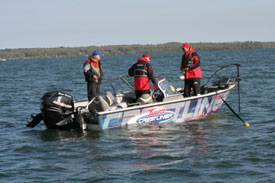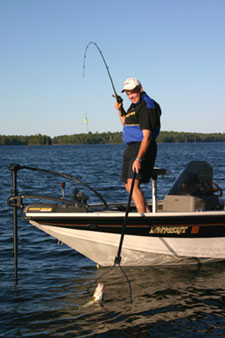 Successful walleye anglers know that to have any chance of loading the boat they need to be in complete control of their craft at all times. That means the ability to control speed and direction, no matter what the conditions. If you can control your boat you can control your bait allowing you to keep your offering in the “zone” and maximize your opportunities. Anything less can result in fewer or even no fish caught, and that’s never any fun (in my opinion). While there may be certain situations that are completely beyond your reach, most of it can be dealt with.
Successful walleye anglers know that to have any chance of loading the boat they need to be in complete control of their craft at all times. That means the ability to control speed and direction, no matter what the conditions. If you can control your boat you can control your bait allowing you to keep your offering in the “zone” and maximize your opportunities. Anything less can result in fewer or even no fish caught, and that’s never any fun (in my opinion). While there may be certain situations that are completely beyond your reach, most of it can be dealt with.
Calm conditions are a piece of cake and when anybody can stay in control, but it’s a different story when things get rough. Even so with the right gear you can beat a stiff wind and big waves and still come out on top. Starting from the top down today’s boat manufacturers have made big improvements in their hulls that not only ride better and drier but are easier to control. For example; my new Crestliner 1800 Super Hawk is designed to sit level on the water and does so without a high riding bow which would make it more prone to the wind grabbing it and pushing it around. Improvements in electric trolling motors have helped immensely with staying in control and have allowed anglers to tame some of the roughest conditions.
Trying to stay on a tight break line in two to three foot waves takes a lot of thrust and a little coordination to get the job done. Today’s most powerful trolling motors like Minn Kota’s Terrova and Vantage are available in models up to an amazing 101lbs of thrust and can help you stay where you want when you want to be there. If you back it all up with high quality batteries like those built by Optima with Spiralcell technology you can run all day and have power to spare, and they really do make a difference. To give you an example; I was having trouble losing power last year and thought I wasn’t getting a full charge. What I found was the problem wasn’t with the charging system. Instead it was the fact that my riggers used another brand of battery and they didn’t have the same high reserve capacity!
Speed is another important element and is critical to successful trolling presentations. Finding and duplicating productive speeds can be a rather frustrating endeavor, especially if you’ve tried to accomplish the task with standard equipment, like a depth finder with a speed indicator. The depth finder indicators utilize a paddle wheel type sensor and work well under calm conditions. However, they become totally useless when you throw in a little wind. The problem arises as the wind kicks up and you start to get surface current. For example, a trolling run with the wind may be indicated by a zero speed reading, even though you’re running up to two mph or more.
 Today’s more accurate G.P.S. units like Humminbird’s new 1197c can help and will display a speed reading that you can actually use down to tenths of a mph. Now that you know how fast you’re running achieving an exact speed is the next problem. Trying to get an outboard to run at a specific speed can be tough, especially at slower speeds. My Optimax does an excellent job down to about two mph and is about all I ever need. To get down any slower you can drop a drift sock off the bow but it does under steer a bit when trolling forward. Serious trollers may opt for a kicker motor like Mercury’s 9.9hp ProKicker which is a four stroke engine with power tilt that can run all day on minimal amount of gas.
Today’s more accurate G.P.S. units like Humminbird’s new 1197c can help and will display a speed reading that you can actually use down to tenths of a mph. Now that you know how fast you’re running achieving an exact speed is the next problem. Trying to get an outboard to run at a specific speed can be tough, especially at slower speeds. My Optimax does an excellent job down to about two mph and is about all I ever need. To get down any slower you can drop a drift sock off the bow but it does under steer a bit when trolling forward. Serious trollers may opt for a kicker motor like Mercury’s 9.9hp ProKicker which is a four stroke engine with power tilt that can run all day on minimal amount of gas.
Drift socks like Minn Kotas MKA-27 are also the answer to controlling a drifting presentation and it wouldn’t hurt to have at least a couple in the boat. The MKA-27 drift sock has built-in floats and weights that help it to open quickly and has a strap connected to that back of the sock that will allow you to pull it out backwards and empty it before pulling it in the boat.
To hit the right speed you can experiment with a single smaller sock for light wind conditions, or maybe two larger bags for high winds and rough seas. A sock with a larger bag should be used to handle the bow, while a smaller bag can take care of the rear of the boat. The bow will drift faster than the transom and the two bag setup will help to keep you square. With socks out you can use an electric trolling motor or even the main engine if you need to move the boat forward or back.
An anchor may seem like a simple item and is, but it can make all the difference when you want to take control and camp out on a spot. There are different high tech styles available but day in and day out it’s a plain old twenty-eight pound navy anchor and a hundred and fifty feet of rope that keeps me hooked up and on the fish. A twenty-eight pounder is a lot to deal with when it’s time to pick it up but when it’s dropped it will usually stay put, and that’s extremely important.
When you lose control you lose confidence, and confidence plays an important part in angler’s success. By taking control you’ll soon find that there are plenty of fish to be caught, even under the some of the toughest conditions.










